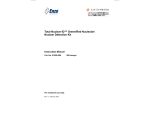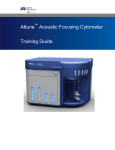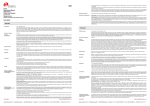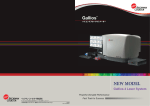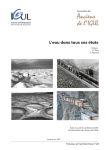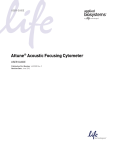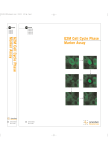Download User Manual-ENZ-51009-500
Transcript
Nucleolar-ID™ Green Detection Kit for Fluorescence Microscopy Instruction Manual Cat. No. 51009-500 For research use only. Rev. 1.0 April 2009 500 assays Notice to Purchaser The Nucleolar-ID™ Green Detection Kit is a member of the CELLestial™ product line, reagents and assay kits comprising fluorescent molecular probes that have been extensively benchmarked for live cell analysis applications. CELLestial™ reagents and kits are optimal for use in demanding imaging applications, such as confocal microscopy, flow cytometry and HCS, where consistency and reproducibility are required. This product is manufactured and sold by ENZO LIFE SCIENCES, INC. for research use only by the end-user in the research market and is not intended for diagnostic or therapeutic use. Purchase does not include any right or license to use, develop or otherwise exploit this product commercially. Any commercial use, development or exploitation of this product or development using this product without the express prior written authorization of ENZO LIFE SCIENCES, INC. is strictly prohibited. Limited Warranty These products are offered under a limited warranty. The products are guaranteed to meet appropriate specifications described in the package insert at the time of shipment. Enzo Life Sciences’ sole obligation is to replace the product to the extent of the purchase price. All claims must be made to Enzo Life Sciences, Inc. within five (5) days of receipt of order. Trademarks and Patents Enzo, CELLestial, Nucleolar-ID and Nuclear-ID are trademarks of Enzo Life Sciences, Inc. Vybrant and DyeCycle are trademarks of Life Technologies. Draq is a trademark of Biostatus Limited. Several of Enzo’s products and product applications are covered by US and foreign patents and patents pending. Contents I. Introduction ............................................................... 1 II. Reagents Provided and Storage.............................. 2 III. Additional Materials Required ................................. 2 IV. Safety Warnings and Precautions........................... 2 V. Methods and Procedures ......................................... 3 A. REAGENT PREPARATION ........................................... 3 B. CELL PREPARATIONS ................................................. 4 C. STAINING LIVE, ADHERENT CELLS............................ 4 D. STAINING LIVE CELLS GROWN IN SUSPENSION ..... 5 VI. Appendices ............................................................... 5 A. FILTER SET SELECTION ............................................ 5 B. RESULTS ..................................................................... 6 VII. References ................................................................ 6 VIII. Troubleshooting Guide ........................................... 7 I. Introduction Enzo Life Sciences’ Nucleolar-ID™ Green Detection Kit contains a proprietary dye suitable for live-cell staining of nucleoli. The dye allows examination of nucleolar dynamic changes in intracellular distribution, trafficking and localization arising from biological processes such as the cell cycle and ribosome biogenesis. Historically, nucleolus imaging approaches have required much more laborious and time consuming methods, such as fluorescently labeled RNA microinjection, fluorescence in situ hybridization (FISH) or use of fluorescent protein-tagged RNA binding proteins (GFP or YFP constructs). The nucleolus represents a highly dynamic nuclear domain arising from an equilibrium between the level of ribosomal RNA synthesis and the efficiency of ribosomal RNA processing.1,2 Although the nucleolus is primarily associated with ribosome biogenesis, several lines of evidence demonstrate that it has additional functions, such as regulation of mitosis, cell-cycle progression and proliferation, and many forms of stress response and biogenesis of multiple ribonucleoprotein particles. Ribosome biogenesis is regulated throughout interphase and ceases during mitosis. Thus, there is a direct relationship between cell growth and nucleolar activities. Nucleoli are well known to be dramatically modified in cancer cells. Additionally, a large number of key proteins from both DNA- and RNAcontaining viruses are localized in the nucleolus, including the HIV-1 (human immunodeficiency virus type 1) Rev and Tat proteins. Targeting of viral proteins to the nucleolus not only facilitates virus replication, but may also be required for pathogenic processes. The nucleolus is also a sensor of stress due to the redistribution of the ribosomal proteins in the nucleoplasm through its disruption. The Nucleolar-ID™ Red Detection Kit is specifically designed for visualizing nucleoli in living cells by fluorescence microscopy. The dye in the kit is resistant to photobleaching, facilitating its use in imaging applications. This nucleolar stain is compatible with common live-cell nuclear stains such as Hoechst 33342, Draq5™, Vybrant® DyeCycle™ Ruby and Enzo’s Nuclear-ID™ Red dye. The kit includes a control nucleolus perturbation agent, actinomycin D, for monitoring changes in nucleolar dynamics. Actinomycin D, an antibiotic, is a DNA-dependent RNA synthesis inhibitor. Nucleolar synthesis of ribosomal RNA is especially sensitive to actinomycin D. Potential applications for this kit include monitoring of impaired ribosome biogenesis, inhibition of transcription, cell cycle dynamics, cellular stress, distribution, trafficking and dynamics of nucleolar proteins, distribution of viral proteins, and potentially, as an aid to identify cancer cells. 1 II. Reagents Provided and Storage All reagents are shipped on dry ice. Upon receipt, the kit should be stored at ≤-20°C, protected from light. When stored properly, these reagents are stable for at least twelve months. Avoid repeated freezing and thawing. Reagents provided in the kit are sufficient for approximately 500 assays using either live, adherent cells or cells in suspension. Reagent Quantity Nucleolar-ID™ Green Detection Reagent 50 µL Actinomycin D Control 125 µg 10X Assay Buffer 15 mL III. Additional Materials Required • Standard fluorescence microscope • Calibrated, adjustable precision pipetters, preferably with disposable plastic tips • Adjustable speed centrifuge with swinging buckets (for suspension cultures) • Glass microscope slides • Glass cover slips • Deionized water • Anhydrous DMSO (optional) • Growth medium (e.g., Dulbecco’s Modified Eagle Medium, D-MEM) IV. Safety Warnings and Precautions • This product is for research use only and is not intended for diagnostic purposes. • The Nucleolar-ID™ Green Red Detection Reagent contains DMSO which is readily absorbed through the skin. DMSO is harmful if ingested or absorbed through the skin and may cause irritation to the eyes. Observe appropriate precautions when handling these reagents. • Reagents should be treated as possible mutagens and should be handled with care and disposed of properly. • Observe good laboratory practices. Gloves, lab coat, and protective eyewear should always be worn. Never pipet by mouth. Do not eat, drink or smoke in the laboratory areas. All blood components and biological materials should be treated as potentially hazardous and 2 handled as such. They should be disposed of in accordance with established safety procedures. • To avoid photobleaching, perform all manipulations in low light environments or protected from light by other means. V. Methods and Procedures NOTE: Allow all reagents to thaw at room temperature before starting with the procedures. Upon thawing, gently hand-mix or vortex the reagents prior to use to ensure a homogenous solution. Briefly centrifuge the vials at the time of first use, as well as for all subsequent uses, to gather the contents at the bottom of the tube. A. REAGENT PREPARATION 1. Positive Control The antibiotic, actinomycin D is a DNA-dependent RNA synthesis inhibitor. Nucleolar synthesis of ribosomal RNA is especially sensitive to actinomycin D. The rearrangement of the nucleolus due to actinomycin D treatment is widely used to examine the localization of various nucleolar components, including nucleolar proteins.3 Typically, at higher doses of the drug (4-10 µg/ml for 4 hours), the nucleolus in mammalian cells disappears, or where still present, is dramatically reduced in amount, while at lower concentrations (1-4 µg/ml for 4 hours), less dramatic reduction in nucleolar amount is often observed. The actinomycin D provided in the kit may be used as a positive control for reducing nucleoli size and number. It is supplied lyophilized (125 µg) and should be centrifuged briefly to gather the material at the bottom of the tube. Reconstitute the lyophilized material in 250 µL deionized water for a 0.5 mg/mL stock solution. Vortex vigorously, allow to sit for 15 minutes, then vortex again to completely bring it into solution. It is recommended that treatment with the agent be performed using 1-5 µg/mL final concentration in order to observe changes in nucleolar morphology. Unused stock actinomycin D may be stored in small aliquots at -20°C for several weeks. 2. 1X Assay Buffer Allow the 10X Assay Buffer to warm to room temperature. Make sure that the reagent is free of any crystallization before dilution. Prepare enough 1X Assay Buffer for the number of samples to be assayed by diluting each milliliter (mL) of the 10X Assay Buffer with 9 mL of deionized water. 3 3. Detection Reagent The concentration of Nucleolar-ID™ Green dye for optimal staining will vary depending upon the application. Suggestions are provided to use as guidelines, though some modifications may be required depending upon the particular cell type employed and other factors such as the permeability of the dye to the cells or tissues. To reduce potential artifacts from overloading of the cells, the concentration of the dye should be kept as low as possible. Prepare sufficient amount of the Detection Reagent for the number of samples to be assayed as follows: To each mL of 1X Assay Buffer (see preparation in step 2, page 3) or cell culture medium containing serum, add 1 µL of Nucleolar-ID™ Green Detection Reagent. Serum may be included, if preferred. NOTE: If desired, other stains such as Hoechst 33342, Draq5™ or Enzo’s Nuclear-ID™ Red dye may be added to the diluted Nucleolar-ID™ Green Detection Reagent at this time. B. CELL PREPARATIONS Cells should be maintained via standard tissue culture practices. Positive control cells should be pretreated with the actinomycin D control for 2-6 hours. Response to actinomycin D is time and concentration dependent and may also vary significantly depending upon cell type and cell line. Negative control cells should be treated with a vehicle (DMSO, media or other solvent used to reconstitute or dilute an inducer or inhibitor) for an equal length of time under similar conditions. C. STAINING LIVE, ADHERENT CELLS 1. Grow cells on cover slips inside a Petri dish filled with the appropriate culture medium. When the cells have reached the desired level of confluence, carefully remove the medium. 2. Dispense sufficient volume of Detection Reagent (see section V-A3, above) to cover the monolayer cells (~100 µL of labeling solution for cells grown on an 18 X 18 mm coverslip). 3. Protect samples from light and incubate for 15-30 minutes at 37°C. 4. Wash the cells with 100 µL 1X Assay Buffer. Remove excess buffer and place coverslip on slide. 5. Analyze the stained cells by wide-field fluorescence or confocal microscopy (60X magnification recommended). Use a standard FITC filter set for imaging the nucleolus. 4 D. STAINING LIVE CELLS GROWN IN SUSPENSION 1. Centrifuge cells for 5 minutes at 400 x g at room temperature (RT) to obtain a cell pellet. 2. Carefully remove the supernatant by aspiration and dispense sufficient volume of Detection Reagent (see section V-A3, page 4) to cover the dispersed cell pellet. 3. Protect samples from light and incubate for 15 to 30 minutes at 37°C. 4. Wash the cells with 100 µL 1X Assay Buffer. Remove excess buffer. Resuspend cells in 100 µL 1X Assay Buffer, then apply the cells to a glass slide and overlay with a coverslip. 5. Analyze the stained cells by wide-field fluorescence or confocal microscopy (60X magnification recommended). Use a standard FITC filter set for imaging the nucleolus. VI. APPENDICES A. FILTER SET SELECTION The selection of optimal filter sets for a fluorescence microscopy application requires matching the optical filter specifications to the spectral characteristics of the dyes employed in the analysis. Consult the microscope or filter set manufacturer for assistance in selecting optimal filter sets for your microscope. Figure 1. Absorption and fluorescence emission spectra for Nucleolar-ID™ Green dye. Spectrum was determined in 1X Assay Buffer. 5 B. RESULTS Ribosomal RNAs (rRNAs) are synthesized, processed and assembled with ribosomal proteins in the nucleolus. In mammalian cells, the nucleolus is disorganized in prophase and reassembled at the end of mitosis using the nucleolar machineries from the previous cell cycle. Ribosomal DNA (rDNA) transcription is maximal in the S and G2 phases, silent in mitosis, and slowly recovers in the G1 phase of the cell cycle. The nucleolus is a prominent nuclear structure in cycling cells but of limited size in the terminal stages of cell differentiation. Cells stained with Nucleolar-ID™ Green Detection Reagent show maximal fluorescence signal within the nucleoli, and faint fluorescence throughout the nucleus. Weak fluorescence is also observed throughout the cytoplasm, predominantly associated with mitochondria. The dye displays high cellular plasma and nuclear membrane permeability, and is well tolerated by living cells. The number of nucleoli in different cell types observed with the Nucleolar-ID™ Green Detection Reagent will vary and they will be of different sizes as well. There appears to be an inverse relationship between size and number of nucleoli in mammalian cells.2 For example, HeLa human cervical carcinoma cells, stained using the Nuclear-ID™ Green Detection Reagent typically display two prominent nucleoli per cell, while U2OS human bone osteosarcoma epithelial cells are observed to contain a half dozen smaller nucleoli. Ribosomal DNA (rDNA) transcriptional arrest, induced by low doses of actinomycin D, results in loss of nucleolar staining in both cell lines as observed with the Nucleolar-ID™ Green Detection Reagent in the kit. The dissipation of nucleolar signal induced by actinomycin D is likely to coincide with rRNA degradation events known to occur during treatment with this drug. However, it is not definitively established whether the dye interacts with rRNA, with arginine/lysine-rich sequences in nucleolar proteins or with some other structural feature of nucleoli. Nucleolar-ID™ Green dye does bind nucleic acids in solution, but does not show significant selectivity towards RNA relative to DNA in such in vitro experiments. VII. References 1. Hernandez-Verdun and Roussel (2003) “Regulators of nucleolar functions” Progress in Cell Cycle Research, Vol. 5, (Meijer, Jézéquel and Roberge, eds.) Chapter 31 pp 301-308. 2. Sirri , Urcuqui-Inchima, Roussel and Hernandez-Verdun (2008) “Nucleolus: the fascinating nuclear body” Histochem Cell Biol 129: 13–31. 3. Smetanaa, Buscha, Chana, Smetana and Busch (2001) “Immunocytochemical localization of nucleophosmin and RH-II/Gu 6 protein in nucleoli of HeLa cells after treatment with actinomycin D” Acta Histochemica 103, (3): 325-334. VIII. Troubleshooting Guide Problem Potential Cause Suggestion Nucleoli are not sufficiently stained. Very low concentration of Nucleolar-ID™ Green dye was used or dye was incubated with the cells for an insufficient length of time. Either increase the labeling concentration or increase the time allowed for the dye to accumulate in the nucleoli. Nucleolar-ID™ Green dye fails to stain the nucleoli in fixed and/or permeabilized cells. The Nucleolar-ID™ Green Detection Reagent provided in the kit is only suitable for live-cell staining. Use the dye only for livecell analysis. Precipitate is seen in the 10X Assay Buffer. Precipitate forms at low temperatures. Allow solution to warm to room temperature or 37°C, then vortex to dissolve all precipitate. The Nucleolar-ID™ Green stain is too bright compared to the red nuclear stain. Different microscopes, cameras and filters may make some signals appear very bright. Reduce the concentration of the Nucleolar-ID™ Green dye or shorten the exposure time. Cells do not appear healthy. Some cells require serum to remain healthy. Add serum to the staining solution. Serum does not affect staining. Normal amounts of serum added range from 2% to 10%. Actinomycin D Control does not go into solution. The recommended volume to dissolve actinomycin D is near the limit of solubility. Ambient temperature may affect solubility. Warm the solution to 37°C to dissolve, or dissolve in a larger volume. Actinomycin D treated cells apper dead or are no longer attached to the surface. The EC50 of actinomycin D may be different with different cell lines. Lower the dose of actinomycin D, or shorten the time of exposure. 7 www.enzolifesciences.com












